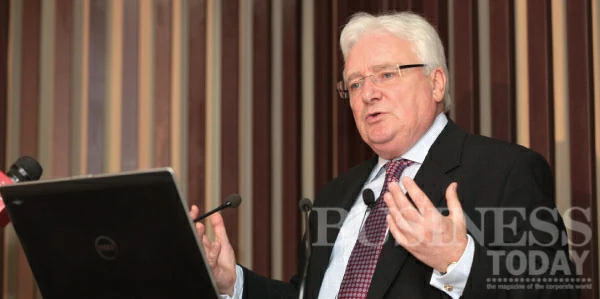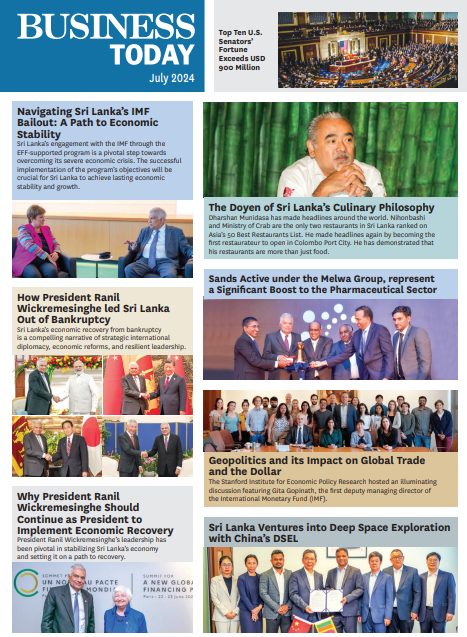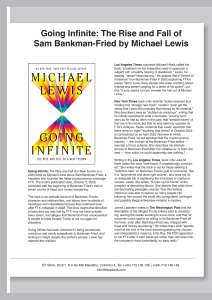
MILODA, the Academy of Financial Studies imparting a wealth of knowledge to the society hosts informative sessions where eminent speakers share their experience and expertise. Following is a summary, which looks at Leadership Qualities necessary to lead organisational change, Contemporary Thrust of Sri Lanka’s Development Strategy and Consolidation of Banking.
Compiled by Krishani Pieris and Prasadini Nanayakkara
“Steering Through 2014-2020, Must Have Leadership Qualities to Lead Organisational Change”
Peter Archterstaraat, Evans and Peck Principal of the Global Infrastructure and Resources Advisory Firm and the former Auditor General of New South Wales delivered his address Steering Through 2014-2020: Must have Leadership Qualities to Lead Organisational Change as the keynote speaker. With expertise in the fields of Auditing and the Australian Tax System, Peter Archterstaraat has also been recognised for developing the Lighthouse Model with Dr Jeff Harmer for corporate governance of public and private sectors. The model received the award for the Governance Reporting – Public Sector at the Australian Reporting Awards in June 2013 during his term in office.
In reference to the topic of the speech, Dr P B Jayasundera, Secretary, Ministry of Finance and Planning and Secretary to the Treasury noted that the period from 2014-2020 is one where the government and the Central Bank under the current leadership are targeting a ‘10,000 USD per capita income earning nation status’. “We stand today as a very proud country. After 30 years our nation is enjoying unbelievable peace. You do not see Sri Lanka here, what you see is a fraction of what we have lost over 30 years and recaptured. The economic situation of the country is such that the Governor of the Central Bank of Sri Lanka can proudly approach not just any Central Bank in the world, but Central Banks of the G20 countries as he is representing a country, which has one of the lowest inflation rates in the world,” Dr Jayasundera went on to say.
“In terms of our assessment we are experiencing a more sustainable transformation in the country. The country has achieved a seven percent growth even under difficult conditions… when the economy is in a challenging place in terms of adjusting to the difficult global environment; when many tax and physical reforms were imposed; when the economy was placed on a public investment drive. The economy is also managing post-conflict challenges while the populace of the country is still emerging from the mindset influenced by the conflict. The country is also enjoying democracy. We have elections, freedom of expressions and freedom for the establishment of trade unions. Hence, in that context, what Sri Lanka has achieved is a remarkable achievement. And from my point of view, it is a story of success,” says Dr Jayasundera.
In this backdrop there is a need to strengthen the manner in which various activities are conducted and responsibilities are managed; an area where Peter Archterstaraat could offer insight.
As the Auditor General of a country with 500 different departments and 100 different projects Peter Archterstaraat posed the question of why certain projects go wrong. Even with the exact same resources one department could successfully complete project while the other could not. Upon questioning heads of department the answer came to light – leadership.
“I spoke to these leaders to get their views… this was really effective. It is not a mere exercise. We have statistics proving the fact that effective leadership increases productivity,” stated Archterstaraat adding that, “having applied what I learnt from these interviews with the people, I was able to implement new strategies in my department. And I have been able to come up with-quite significantly-higher figures.”
He observed that where change was handled well, the figures were significantly higher. Thereby the first question posed was ‘what key qualities are needed to be a leader?’ And secondly, ‘do public sector leaders need qualities different to private sector leaders?’
From the survey that involved 60-70 leaders top ten leadership qualities were ranked from a list of 40. The ten values that arose were: communication skills; high integrity; ability to deal with complex, ambiguous and uncertain agendas; engaging with multiple stakeholders; passion; values; sound judgment; accepting responsibility and accountability; developing staff; and appropriate risk taking.
“When It Comes To Integrity, People Would Not Believe The Message If The Messenger Is Not Credible. Therefore The Messenger Has To Have High Integrity.”
These values were then divided into three groups – attributes, skills and behaviour. Attributes are innate skills such as brainpower and cooperating skills, without which no amount of training can bring about a change in a leader. “Our attributes are who we are. The skills are what we can do, and behaviour is what we do. In training leaders, you might be not able to do much on attributes but you can certainly train and improve skills and behaviour,” explained Archterstaraat.
When the study posed a list of attributes- integrity, empathy, judgment, emotional intelligence, charisma, self esteem, optimism- to reveal which qualities were the most important, while majority agreed that they were all important, integrity was ranked the most important. Charisma was listed last among all. “When it comes to integrity, people would not believe the message if the messenger is not credible. Therefore the messenger has to have high integrity,” added Archterstaraat.
Among skills the ‘ability to engage with a wide range of stakeholders’ was listed the most important among analytical thinking, strategic thinking, creativity, ability to develop a vision, ability to communicate and straightforward problem solving.
Out of the behaviours a leader should be: a role model; a listener; someone who can inspire others; someone who continually reinforces the message; a team player; a change agent; someone who takes risks; invest in others; delegates plans and outcomes and is customer focused. The survey showed that the ability to inspire your team players as the most important. Archterstaraat then shifted focus on the differences between a private sector leader and a public sector leader. While there are three types of public sector leaders; political leaders, civic leaders and organizational CEOs. According to the results of the survey, leaders of both public and private sectors need the following skills: being a good communicator, ability to set a vision and being people focused.
“The Public Sector Needs To Be More Vigilant Than The Private Sector When Working With Stakeholders And The Public Sector Needs To Be Able To Inspire The Staff Using Tools Other Than Remuneration.”
The differences according to the survey reveal that a chairman in a private company has different needs than a minister in the public sector; shareholders in the private sector have different needs than that of the public sector; there is a difference in scrutiny in the private sector and different budget estimations in the public sector and the rationale for doing the job is different. “In the public sector we are stewards for other people’s money and goods whereas the private sector works for profit. The private sector has a better management of skills and capital raising. The public sector needs to be more vigilant than the private sector when working with stakeholders and the public sector needs to be able to inspire the staff using tools other than remuneration,” elaborated Archterstaraat.
When considering capital raising, there is a need for skills in capital raising in the public sector. Today words have changed from ‘give me the money’ to ‘invest in me’. Thereby the delivery agencies need to be able to raise capital admittedly from the Treasury. Thereby Archterstaraat further stressed that leaders have to be genuine and engaging. They need to be able to deal with volatile and certain ambiguous and conflicting agenda. They need to communicate in time and be able to influence people over whom they don’t have control.
For the success of an organisation there should be an effective change management methodology. “I use the Lincoln model of strategic planning where all levels of the organisation know where they came from and where they are headed… what should be done and how it should be done.” Apart from a good change management methodology, good strategic planning and good capabilities, an extra factor that is required is leadership. In summary, new leaders need to deal with new types of communication; be able to instill trust; they need their staff and their stakeholders to trust them; and be able to deal with ambiguous, volatile and complex agenda.
Contemporary thrust of Sri Lanka’s development strategy
Dr P B Jayasundera, Secretary to the Treasury gave the key note speech at the Memorial Oration and Inauguration of the Memorial Scholarship Fund where he paid tribute to Dr W M Tilakaratna highlighting the illustrious career of Dr Tilakaratna along with the important historical economic measures that shaped our economy during the time. He further communicated the trust and the attention cultivated by the government towards an all-inclusive development in Sri Lanka.
Having graduated from the University of Ceylon with a BA in 1949, Dr Tilakaratna joined the income tax department where he worked until 1952 before starting his career at the Central Bank of Ceylon in 1953.
Determined on enriching his knowledge as a young economist, Dr Tilakaratna pursued his post graduate studies at the London School of Economics where he presented a thesis titled “Agricultural Credit in a Developing Economy – Ceylon”. Quoting part of Dr Tilakaratna’s thesis that described the rural agricultural sector in Sri Lanka at the time, Dr Jayasundera demonstrated the lack of a developed model in the economy in order to transform the country’s economy to an integrated one based on comparative advantage. “The demands of the economy was linked very much to imports. On the positive side however there were some initiatives towards broadening the frontiers of education and health thanks to the free delivery mechanism engineered during state council days,” he affirmed.
The period between 1946-1949 was a time characterised by much excitement due to the country’s transition to Independence, but this was soon replaced with economic challenges brought on by the collapse of the Korean War economic boom. Dr Jayasundera describing the challenges faced at the time said, “The Central Bank Annual Report of 1952 described this as “Ceylon lived far beyond its means”. The Annual Report articulated that the underlying difficulty in 1952 was that the country as a whole had become accustomed during the Korean War boom, to a level and pattern of expenditure that it could not afford to maintain after the boom subsided.” As such measures were taken to tighten the exchange control under Finance Regulation and the Exchange Control Act came into force in 1953.
The Sri Lankan economy reflected structural weaknesses while the plantation economy that produced a modern urban economy left the rural economy behind. Further, when looking at the economy in a global context, entire Asia was poor with the exception of Japan. Relaying the vulnerability of the Sri Lankan economy Dr Jayasundera reflected, “The entire real economy was built on a primary commodity export structure and the Korean War boom, hence the associated fiscal strategies in a way nurtured the crisis.”
The year 1956 saw Sri Lanka on a new development regime with the general elections and the popular trend towards state-run economies in the third world countries, “which included nationalisation of foreign and domestic private enterprises, import substitution-led industrialisation and the regulation of production, consumption and distribution. Centre-left politics and centre-right politics travelled along this road with adjustments mostly compromised due to political pressure.”
The generation of Central Bankers of Dr Jayasundera’s time joined the Central Bank in the 1970’s at the very end of the closed economy and in 1976 they witnessed the revaluation of the exchange rate by the then Finance Minister Felix Dias Banadaranaike. Further, some of the other main developments that occurred during the time signalling the beginning of significant changes to the banking sector was the establishment of the People’s Bank and National Savings Bank in 1961 and 1971 respectively.
The 1977 General Elections took place in the backdrop of yet again a 20 year State-run economic model, similar to 1956 scenario, where poor growth rates and a highly regulated environment were common characteristics prevalent in third world countries. “Very few countries that were exceptions, such as Singapore, Hong Kong, South Korea and Taiwan, did not adopt the popular third world development strategies in the 1960s and 1970s and instead followed an export oriented path. They ended up being high performing Tiger Economies, bypassing us rapidly,” said Dr Jayasundera.
The economy was liberalised in 1977 and Dr Tilakaratna as the Senior Deputy Governor of the Central Bank was part of the initial team that worked with Ronnie De Mel, the Minister of Finance in the Government of President J R Jayawardena. Dr Tilakaratna retired from the Central Bank in 1978 after which he “took up the appointment as secretary to the ministry of finance and became the ex-official member of the monetary board of the Central Bank.”
Further Dr Jayasundera reflected that, “the outcome of the first ten years of post 1977 reforms did not live up to expectations” as the momentum of post 1977 reforms and the public investment drive was lost by 1988. He mentioned that though there were political stability, ample competent technocrats and support from international financial institutions, Sri Lanka was not able to manage the intended reforms and development programmes, partly due to economic reasons and largely due to LTTE led terrorism.
In the period following the 1988 Presidential elections, many reforms on privatization were implemented while poverty reduction and taking industries to rural areas were given priority. A major milestone achieved at the time was the acceptance of Article VIII Status of the IMF that formed restrictions on current account transactions. The Government that came to power in the general elections of 1994 focused on changing the economic policies implemented since 1977 while endeavoring to restore peace. Other milestones accomplished during the time were the deregulation and the relaxation of entry barriers in the telecommunication industry and free-float in the exchange rate regime.
“But once again the absence of corresponding domestic reforms placed the entire burden on the monetary and foreign exchange markets… The 2005 Presidential elections took place in this background and the Government of President Rajapaksa got the mandate on an alternate platform,” commented Dr Jayasundera.
Five years have gone by since the end of conflict and Sri Lanka is making strides in terms of development where the country is now able to exploit many avenues of prosperity once denied. The economy of Sri Lanka has reached a middle income status with a per capita income of USD 3,300 as of 2013, extreme poverty has declined, inflation has reduced to the lowest level the country has witnessed, access to facilities such as electricity, water, transport, education, health and much more have improved and all has contributed to as Dr Jayasundera declared “an improved standard of living” not only in the already developed cities and towns but in the once war-torn areas as well.
Reviewing the current policies undertaken by the government Dr Jayasundera said, “the fiscal situation that got out of control under almost all successive Governments, has got a sound footing mainly due to restoration of peace and security that has enabled to keep defence expenditure at a manageable level…and due to required adjustments in public spending, while also accommodating much needed reforms in taxation towards a broad-based low tax regime.” Further he appreciated the support extended by the World Bank, Asian Development Bank and the bilateral development partners as well. Another fact communicated by Dr Jayasundera was the importance of bringing all stakeholders, especially those involved in financing to a well integrated development policy framework where uniform systems and procedures are applied with inclusive development strategies. And this aspect forms the thrust of Mahinda Chintana – the ten year Development Framework of the Government.
“What Is Probably Lacking Is That We Are Not Projecting Our Success Story Loud And Clear. Continuous Refinements To Policy Strategies Of The Post 2005 Period Have Worked Well.”
Dr Jayasundera while revealing the vital role imparted by the banking sector in development stressed that “the cornerstone of the contemporary development thrust lies with the rural agricultural economy… I am sure that nobody will disagree with me if I say that no meaningful and balance development is possible in Sri Lanka until and unless the rural population is made more productive.”
Affirming the importance of an all-inclusive development as supported by the country’s experienced and by eminent economist such as Dr W M Tilakaratna, Dr Jayasundera concluded, “what is probably lacking is that we are not projecting our success story loud and clear. Continuous refinements to policy strategies of the post 2005 period, which have worked well in this country and further consolidation of a balanced blend of the private and public sector role with special emphasis on the small sector and remaining facets of poverty in my view, will make Sri Lanka’s progress towards a USD 7,000 per capita income by 2020. An ambitious target of less than ten percent poverty head count below two dollars a day income is recognised for the medium term as the elimination of extreme poverty has been almost realised. Some may describe this as too ambitious but I would argue it is still sub optimal given the country’s recent progress.”
Consolidation of Banking: Dr P B Jayasundera
Dr P B Jayasundera Recognising the extremely strong growth environment in the country Dr P B Jayasundera noted that growth is more than a statistical figure as it underlies strong resilience in the economy for multi-faceted adjustments that any economy has to go through in a competitive environment.
The country is also moving towards a more consolidated economic story in terms of infrastructure and many of the infrastructure projects put in place today are those that the country should have had in 1977.
“It Is Essentially The Growth Story Though We Are Looking At And At The Other Side Of The Equation, The Real Economy Is You.”
“His Excellency the President recognised that the budget is about economics and not simply a political instrument.” Consequently Dr P B Jayasundera noted that the fiscal deficit is at its lowest in post-independent Sri Lanka. He also added that the Central Bank today is in an autonomous entity.
“It is essentially the growth story though we are looking at and at the other side of the equation, the real economy is you… from day-to-day consumption to much longer investments. In that sense we believe success is generally due to holding rather than letting it go. Our country needs a continuous success story now. And the financial sector is very critical,” he stated.
Dr Jayasundera also pointed out the many positive indicators in particular poverty, which has dropped to four percent. Furthermore for the first time in this country the growth rate is above inflation.
“The role of Government is essentially to create the enabling environment and we are providing that by bringing everybody together. We don’t want to have individual problems or solutions. Collectively your sectors must now grow with transparency and accountability, where we will provide security and good governance… You all must consolidate.”
He further stated that in doing so and in developing a growth-oriented story it is essential to mobilise experts. Michael H Ellis, is a distinguished British banker who has 25 years experience in financial services mainly with Halifax, which was created in 2001 with a merger between Halifax and Bank of Scotland.
He has varied expertise ranging from Treasury to retail banking services and integrations. From September 2001 to October 2004 he was the Group Finance Director of HBOS having previously served a Senior Executive and Board Member of Halifax. He left HBOS at the end of 2004 returning in September 2007 to resume the role of Group Finance Director from January 2008 to January 2009. Since May 2011 Michael Ellis has been the non-executive Chairman of Skipton Building Society in the UK. He also runs his own advisory and consulting business with the focus on international financial services. In 2007 he was awarded OBE for his contribution to the UK financial service.
Dr P B Jayasundera noted that, the Central Bank is making a commitment to see that the country will see a much stronger financial system that will have a foreign domestic mixture of the right scale in terms of banking and financial institutional operation. This is so that the country will have the right products towards a vibrant economy. “We hope that the Governor’s commitment and effort and our support and commitment by providing the right enabling environment will ensure the country will have a decent, stable macro economic environment to cross the single digit growth rate to double digit growth rate in time to come.”
Governor of Central Bank
“When I first became governor our interest rates were in the mid 20s and at that time the nation was barely on an upward march, growth was stagnant. Today it is different. That has been as a result of a very closely structured effort. Nothing happened by accident. Each year there was a strategy, each year there was commitment towards making that strategy work and each year there was a close connection of minds, between the Treasury and Central Bank in order to ensure that whatever we do had the balance clearly structured,” said Governor Cabraal on moving forward and achieving success. Furthermore the fiscal and monetary harmonisation was carefully crafted and taken forward.
“Each Year There Was A Strategy, Each Year There Was Commitment Towards Making That Strategy Work And Each Year There Was A Close Connection Of Minds, Between The Treasury And Central Bank.”
Of a few areas that have shown results as far as the economy is concerned, from 2009 onwards the country has seen extraordinary developments in infrastructure he stated.”There was a need for funding-both bi-lateral as well as multi-lateral, a need to ensure that the funding did not cause other disturbances or structural problems in the economy. Also that while infrastructure was being developed our main focus on inflation and growth were not disturbed. Sustainability of those programmes was established. All these happened as a result of carefully crafted, carefully designed, carefully executed strategies,” he stressed.
He further recognised that 2014 appears to be the best year to launch a programme of consolidation, which would ensure that one of the few vulnerabilities is also addressed in order to move forward. “This year there is a carefully crafted strategy once again which will be implemented during the year on a methodical basis to ensure that we will have a much stronger financial sector from 2015.”
First identifying strengths and weaknesses, available opportunities, what threats need to be mitigated and accordingly structure the new plan, that comprises of many components. “It talks about the banking sector, particularly the state-banking sector as well as the banking sector, which is being organised by the private sector and then the non-banking financial sector. How are we going to merge those institutions? A clear plan has been laid out, with carefully crafted deadlines, as well as procedures to ensure that it does happen. Today people know when plans are made they are executed. We have endeavoured to ensure that the plan for consolidation is implemented. And there are many components that need to fit in for proper implementation… It is a very intensive exercise. We have approached it in a fairly strategic manner. We have set up within the Central Bank, a unit, which will play the role of arbitrator as well as facilitator. We have addressed key issues with regard to valuations, with regard to consultancies, as to who is going to pay for what, we have addressed issues with regard to the mergers of institutions which have common shareholders and many more,” he explained.
The Governor also stated, “I believe here in this particular instance the banking consolidation we are looking at both a short-term and as well as a very long-term horizon. And I think once we get this right we will be able to have a strong financial sector and with that financial sector we will be able to help and assist the real sector.”
He added that the endeavour is to also position the financial sector for the next 50 years. “that challenge is up to you and I’m sure if we all put our minds together and see that we are able to deliver the promise that we made in the last eight years. We will have a great country, a great financial sector and a great real economy.”
Sir Michael H Ellis
Drawing from his experience Sir Michael H Ellis offered his views from a practical side on consolidation. He stated that it is consolidation that can help bring about strategy, and in turn can bring about the change that people desire. Consequently understanding the driving force behind consolidation, the vitality of planning, programme management and implementation are the important aspects in consolidation.
He stressed that “what works well in some countries may not work well in others” and “being clear on what your strategic objectives are and what you want to get out of consolidation” are essential.
In consolidation one has to take note of the different stakeholders of an organisation as each brings distinct perspectives. As such looking into the needs of the customer, the welfare of the employees and strategically understanding how to open the dialogue in order to discuss the intended objectives among other factors must be given ample consideration.
Explaining further regarding what an organisation would have to undertake to accomplish the consolidation process, Sir Ellis said, “strategies that tend to reflect the regional objectives of all the stakeholders will encounter serious difficulties in one way or another. So thinking through what is the strategy that depends on the consolidation and how you are going to satisfy various stakeholder objectives are key.”
There are several different types of consolidation such as ‘arranged marriage’, straight forward acquisition and merger of equals and each would require a slightly different approach. However, meeting stakeholder objectives and taking into account strategy are common factors for all types of consolidation.
“Once You Choose The Right Partner, You Got To Share A Proper Vision… Consolidation Is Not An End Of Its Own Right But To Build Something Arising From It And That Needs A Clear Vision For The Future.”
Focusing on ‘merger of equals’ to present his views on consolidation, Sir Ellis said that foremost selecting the right partner that provides the best in terms of business opportunity, access to market and merger to return is important.
Further, imparting his thoughts on the types of evaluations needed he affrimed, “once you choose the right partner, you got to share a proper vision… Consolidation is not an end of its own right but to build something arising from it and that needs a clear vision for the future.” Additionally having the right leadership and also obtaining advice of independent experts to help formulate basis of discussion and negotiation would help the consolidaton process as well.
Cautioning against being too optimistic about market mergers though they provide smart and competitive positioning and financial stability among other beneficial factors Sir Ellis stressed the significance of remaining realistic at all times. Consolidation is meant “for the right combination and a clear vision, strategy and leadership can bring all its benefits, provided that the merger is planned and implemented effectively.”
In planning Sir Ellis revealed one should have a framework on how consolidation will take the business forward and how it is implemented while clear communication will play a major role in the process. Further when planning out what is referred to as the ‘new curve’, which envisages how the organisation will look in the future, attention should be given to address issues related to organisational culture, the business model-a centralised or a decentralised one and risk management. In financial planning, Sir Ellis asserted that “liquidity might be one of the driving forces for consolidation,” while one needs to have “a realistic view as to what you can do with the balance sheet.”
Addressing sensitive issues with clarity, some compromise and diligence are essential while keeping the cusotmers and employees informed as to how the new curve will affect them,thereby building the assurance needed.
On a concluding note Sir Ellis said the importance of keeping the press and media informed about what is happening with the consolidation will be “critically important for your success.”











